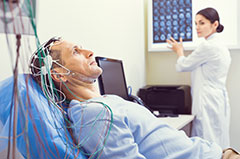 Due to their comprehensive range of properties, epoxies and silicones are used for the manufacturing and assembly of a range of neurological equipment – including neurodiagnostic, neurosurgical, neurointerventional and neurostimulation devices that are used for a broad spectrum of diseases and disorders. Such conditions may include Alzheimer’s disease, epilepsy, stroke, traumatic brain injury, hearing and vision loss, Parkinson’s disease, and major depression, among countless others, for which advanced therapeutic devices and diagnostic accessories are vital.
Due to their comprehensive range of properties, epoxies and silicones are used for the manufacturing and assembly of a range of neurological equipment – including neurodiagnostic, neurosurgical, neurointerventional and neurostimulation devices that are used for a broad spectrum of diseases and disorders. Such conditions may include Alzheimer’s disease, epilepsy, stroke, traumatic brain injury, hearing and vision loss, Parkinson’s disease, and major depression, among countless others, for which advanced therapeutic devices and diagnostic accessories are vital.
Examples of devices in which adhesives, sealants, coatings and potting compounds may be used include: stimulation devices such as nerve or muscle stimulators, brain-computer interface devices and test batteries, exoskeletons and prosthetic devices, electroencephalography and electromyography devices, and even MRI-guided focused ultrasound type devices. Such devices can be key factors in providing sought-after diagnoses, interventions, and lasting relief and rehabilitation for often debilitating and sometimes life-threatening diseases.
Master Bond has a number of products that meet USP Class VI specifications as well as pass the rigorous ISO 10993-5 specifications. These may be suitable for limited contact with tissue/biological materials and other patient contact after customers conduct further testing that complies with FDA regulations.
Our biocompatible epoxies, in particular, may serve as stable barriers to moisture, and certain chemistries are also specially designed for repeated sterilization resistance. Master Bond has biocompatible solutions that additionally offer electrical conductivity and/or thermal conductivity to meet the needs of your assembly with high reliability, whether coating or bonding electrodes or leads, working on die attach configurations, building-in EMI-shielding, or embracing other traditional and even unconventional microelectronics challenges.
Alternatively, our epoxies and silicones may be used as electrically insulating materials in probes or sensors, or as mechanical reinforcement on PCBs where necessary. Some of our materials also offer optical clarity, a property desirable by many engineers.
Epoxies and silicones have become a preferred choice in the medical industry due to their compatibility with many materials, and overarching versatility. Various viscosity options of our biocompatible products may also allow for automated syringe dispensing, jet dispensing, screen printing, or even spin coating, ensuring ease of use as the trend toward miniaturization continues and new micro-fabrication techniques are investigated. For two component materials, specialized packaging in premixed and frozen syringes is also available, which may serve to be advantageous as well for advanced dispensing when two part materials are preferred.
Recent years have seen a great deal of advancement in neurological devices, and we are excited to contribute to bringing technologies and engineering challenges from bench to bedside in this important wave of innovation.
